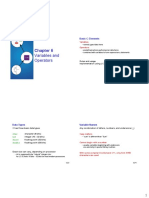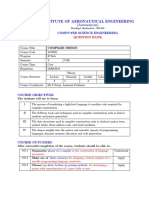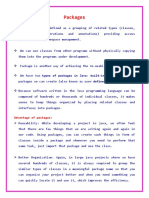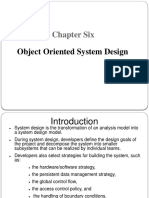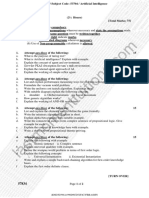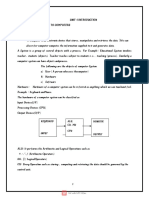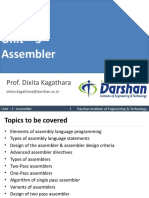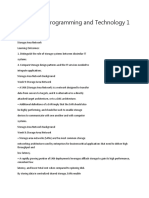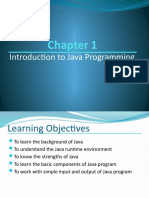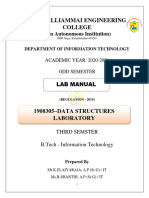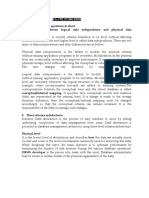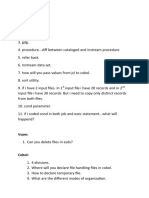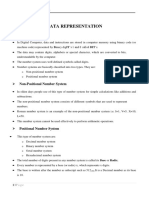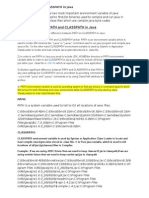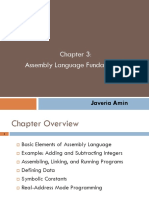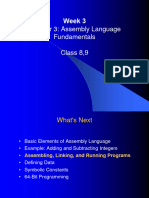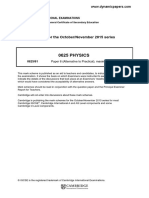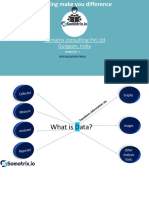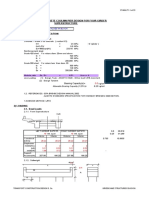Assembly Language
Fundamentals
J. Marwa
�Lecture Overview
Basic Elements of Assembly Language
Example: Adding and Subtracting Integers
Assembling, Linking, and Running Programs
Defining Data
Symbolic Constants
Real-Address Mode Programming
2
�Basic Elements of Assembly
Language
Integer constants
Integer expressions
Character and string constants
Reserved words and identifiers
Directives and instructions
Labels
Mnemonics and Operands
Comments
Examples
3
�Integer Constants
Optional leading + or – sign
binary, decimal, hexadecimal, or octal digits
Common radix characters:
h – hexadecimal
d – decimal
b – binary
Examples: 30d, 6Ah, 42, 1101b
Hexadecimal beginning with letter: 0A5h
4
�Integer Expressions
Operators and precedence levels:
Examples:
5
�Character and String
Constants
Enclose character in single or double quotes
'A', "x"
ASCII character = 1 byte
Enclose strings in single or double quotes
"ABC"
'xyz'
Each character occupies a single byte
Embedded quotes:
'Say "Goodnight," Gracie'
6
�Reserved Words and
Identifiers
Reserved words cannot be used as identifiers
Instruction mnemonics, directives, type attributes, operators, predefined
symbols
See MASM reference in Appendix A
Identifiers
1-247 characters, including digits
not case sensitive
first character must be a letter, _, @, ?, or $
7
�Directives
Commands that are recognized and acted upon by the
assembler
Not part of the Intel instruction set
Used to declare code, data areas, select memory model,
declare procedures, etc.
not case sensitive
Different assemblers have different directives
NASM not the same as MASM, for example
8
�Instructions
Assembled into machine code by assembler
Executed at runtime by the CPU
We use the Intel IA-32 instruction set
An instruction contains:
Label (optional)
Mnemonic(required)
Operand (depends on the instruction)
Comment (optional)
9
�Labels
Act as place markers
marks the address (offset) of code and data
Follow identifer rules
Data label
must be unique
example: count DWORD 100 (not followed by colon)
Code label
target of jump and loop instructions
example: L1: (followed by colon)
10
�Mnemonics and Operands
Instruction Mnemonics
memory aid
examples: MOV, ADD, SUB, MUL, INC, DEC
Operands
constant
constant expression
register
memory (data label)
Constants and constant expressions are often called
immediate values
11
�Comments
Comments are good!
explain the program's purpose
when it was written, and by whom
revision information
tricky coding techniques COMMENT &
application-specific explanations This line is a comment.
Single-line comments This line is a comment.
begin with semicolon (;) &
Multi-line comments
begin with COMMENT directive and a programmer-chosen character
end with the same programmer-chosen character
12
�Instruction Format Examples
No operands
stc ; set Carry flag
One operand
inc eax ; register
inc myByte ; memory
Two operands
add ebx,ecx ; register, register
sub myByte,25 ; memory, constant
add eax,36 * 25 ; register, constant-expression
13
�What's Next
Basic Elements of Assembly Language
Example: Adding and Subtracting Integers
Assembling, Linking, and Running Programs
Defining Data
Symbolic Constants
Real-Address Mode Programming
14
�Example: Adding and Subtracting Integers
TITLE Add and Subtract (AddSub.asm)
; This program adds and subtracts 32-bit integers.
INCLUDE Irvine32.inc
.code
main PROC
mov eax,10000h ; EAX = 10000h
add eax,40000h ; EAX = 50000h
sub eax,20000h ; EAX = 30000h
call DumpRegs ; display registers
exit
main ENDP
END main
15
�Example Output
Program output, showing registers and flags:
EAX=00030000 EBX=7FFDF000 ECX=00000101 EDX=FFFFFFFF
ESI=00000000 EDI=00000000 EBP=0012FFF0 ESP=0012FFC4
EIP=00401024 EFL=00000206 CF=0 SF=0 ZF=0 OF=0
16
�Suggested Coding Standards
(1 of 2)
Some approaches to capitalization
capitalize nothing
capitalize everything
capitalize all reserved words, including instruction mnemonics and
register names
capitalize only directives and operators
Other suggestions
descriptive identifier names
spaces surrounding arithmetic operators
blank lines between procedures
17
�Suggested Coding Standards
(2 of 2)
Indentation and spacing
code and data labels – no indentation
executable instructions – indent 4-5 spaces
comments: begin at column 40-45, aligned vertically
1-3 spaces between instruction and its operands
ex: mov ax,bx
1-2 blank lines between procedures
18
�Program Template
TITLE Program Template (Template.asm)
; Program Description:
; Author:
; Creation Date:
; Revisions:
; Date: Modified by:
INCLUDE Irvine32.inc
.data
; (insert variables here)
.code
main PROC
; (insert executable instructions here)
exit
main ENDP
; (insert additional procedures here)
END main
19
�What's Next
Basic Elements of Assembly Language
Example: Adding and Subtracting Integers
Assembling, Linking, and Running Programs
Defining Data
Symbolic Constants
Real-Address Mode Programming
20
�Assembling, Linking, and Running Programs
Assemble-Link-Execute Cycle
make32.bat
Listing File
Map File
21
�Assemble-Link Execute Cycle
The following diagram describes the steps from creating a
source program through executing the compiled program.
If the source code is modified, Steps 2 through 4 must be
repeated.
Link
Library
Step 2: Step 3: Step 4:
Source assembler Object linker Executable OS loader
Output
File File File
Listing Map
Step 1: text editor File File
22
�Listing File
Use it to see how your program is compiled
Contains
source code
addresses
object code (machine language)
segment names
symbols (variables, procedures, and constants)
23
�Map File
Information about each program segment:
starting address
ending address
size
segment type
24
�What's Next
Basic Elements of Assembly Language
Example: Adding and Subtracting Integers
Assembling, Linking, and Running Programs
Defining Data
Symbolic Constants
Real-Address Mode Programming
25
�Defining Data
Intrinsic Data Types
Data Definition Statement
Defining BYTE and SBYTE Data
Defining WORD and SWORD Data
Defining DWORD and SDWORD Data
Defining QWORD Data
Defining TBYTE Data
Defining Real Number Data
Little Endian Order
Adding Variables to the AddSub Program
Declaring Uninitialized Data
26
�Intrinsic Data Types (1 of 2)
BYTE, SBYTE
8-bit unsigned integer; 8-bit signed integer
WORD, SWORD
16-bit unsigned & signed integer
DWORD, SDWORD
32-bit unsigned & signed integer
QWORD
64-bit integer
TBYTE
80-bit integer
27
�Intrinsic Data Types (2 of 2)
REAL4
4-byte IEEE short real
REAL8
8-byte IEEE long real
REAL10
10-byte IEEE extended real
28
�Data Definition Statement
A data definition statement sets aside storage in memory for a variable.
May optionally assign a name (label) to the data
Syntax:
[name] directive initializer [,initializer] . . .
value1 BYTE 10
All initializers become binary data in memory
29
�Defining BYTE and SBYTE
Data
Each of the following defines a single byte of storage:
value1 BYTE 'A' ; character constant
value2 BYTE 0 ; smallest unsigned byte
value3 BYTE 255 ; largest unsigned byte
value4 SBYTE -128 ; smallest signed byte
value5 SBYTE +127 ; largest signed byte
value6 BYTE ? ; uninitialized byte
30
�Defining Byte Arrays
Examples that use multiple initializers:
list1 BYTE 10,20,30,40
list2 BYTE 10,20,30,40
BYTE 50,60,70,80
BYTE 81,82,83,84
list3 BYTE ?,32,41h,00100010b
list4 BYTE 0Ah,20h,‘A’,22h
31
�Defining Strings (1 of 3)
A string is implemented as an array of characters
For convenience, it is usually enclosed in quotation marks
It often will be null-terminated
Examples:
str1 BYTE "Enter your name",0
str2 BYTE 'Error: halting program',0
str3 BYTE 'A','E','I','O','U'
greeting BYTE "Welcome to the Encryption Demo program "
BYTE "created by Kip Irvine.",0
32
�Defining Strings (2 of 3)
To continue a single string across multiple lines, end each line with a
comma:
menu BYTE "Checking Account",0dh,0ah,0dh,0ah,
"1. Create a new account",0dh,0ah,
"2. Open an existing account",0dh,0ah,
"3. Credit the account",0dh,0ah,
"4. Debit the account",0dh,0ah,
"5. Exit",0ah,0ah,
"Choice> ",0
33
�Defining Strings (3 of 3)
End-of-line character sequence:
0Dh = carriage return
0Ah = line feed
str1 BYTE "Enter your name: ",0Dh,0Ah
BYTE "Enter your address: ",0
newLine BYTE 0Dh,0Ah,0
Idea: Define all strings used by your program in the same area of
the data segment.
34
�Using the DUP Operator
Use DUP to allocate (create space for) an array or string. Syntax:
counter DUP ( argument )
Counter and argument must be constants or constant expressions
var1 BYTE 20 DUP(0) ; 20 bytes, all equal to zero
var2 BYTE 20 DUP(?) ; 20 bytes, uninitialized
var3 BYTE 4 DUP("STACK") ; 20 bytes: "STACKSTACKSTACKSTACK"
var4 BYTE 10,3 DUP(0),20 ; 5 bytes
35
�Defining WORD and SWORD
Data
Define storage for 16-bit integers
or double characters
single value or multiple values
word1 WORD 65535 ; largest unsigned value
word2 SWORD –32768 ; smallest signed value
word3 WORD ? ; uninitialized, unsigned
word4 WORD "AB" ; double characters
myList WORD 1,2,3,4,5 ; array of words
array WORD 5 DUP(?) ; uninitialized array
36
�Defining DWORD and SDWORD
Data
Storage definitions for signed and unsigned 32-bit
integers:
val1 DWORD 12345678h ; unsigned
val2 SDWORD –2147483648 ; signed
val3 DWORD 20 DUP(?) ; unsigned array
val4 SDWORD –3,–2,–1,0,1 ; signed array
37
�Defining QWORD, TBYTE,
Real Data
Storage definitions for quadwords, tenbyte values,
and real numbers:
quad1 QWORD 1234567812345678h
val1 TBYTE 1000000000123456789Ah
rVal1 REAL4 -2.1
rVal2 REAL8 3.2E-260
rVal3 REAL10 4.6E+4096
ShortArray REAL4 20 DUP(0.0)
38
� Little Endian Order
All data types larger than a byte store their individual bytes in reverse
order. The least significant byte occurs at the first (lowest) memory
address.
Example:
val1 DWORD 12345678h
39
�Adding Variables to AddSub
TITLE Add and Subtract, Version 2 (AddSub2.asm)
; This program adds and subtracts 32-bit unsigned
; integers and stores the sum in a variable.
INCLUDE Irvine32.inc
.data
val1 DWORD 10000h
val2 DWORD 40000h
val3 DWORD 20000h
finalVal DWORD ?
.code
main PROC
mov eax,val1 ; start with 10000h
add eax,val2 ; add 40000h
sub eax,val3 ; subtract 20000h
mov finalVal,eax ; store the result (30000h)
call DumpRegs ; display the registers
exit
main ENDP
END main
40
�Declaring Unitialized Data
Use the .data? directive to declare an unintialized data segment:
.data?
Within the segment, declare variables with "?" initializers:
smallArray DWORD 10 DUP(?)
Advantage: the program's EXE file size is reduced.
41
�What's Next
Basic Elements of Assembly Language
Example: Adding and Subtracting Integers
Assembling, Linking, and Running Programs
Defining Data
Symbolic Constants
Real-Address Mode Programming
42
�Symbolic Constants
Equal-Sign Directive
Calculating the Sizes of Arrays and Strings
EQU Directive
TEXTEQU Directive
43
�Equal-Sign Directive
name = expression
expression is a 32-bit integer (expression or constant)
may be redefined
name is called a symbolic constant
good programming style to use symbols
COUNT = 500
.
.
mov al,COUNT
44
�Calculating the Size of a Byte
Array
current location counter: $
subtract address of list
difference is the number of bytes
list BYTE 10,20,30,40
ListSize = ($ - list)
45
�Calculating the Size of a
Word Array
Divide total number of bytes by 2 (the size of a word)
list WORD 1000h,2000h,3000h,4000h
ListSize = ($ - list) / 2
46
�Calculating the Size of a Doubleword Array
Divide total number of bytes by 4 (the size of a doubleword)
list DWORD 1,2,3,4
ListSize = ($ - list) / 4
47
�EQU Directive
Define a symbol as either an integer or text expression.
Cannot be redefined
PI EQU <3.1416>
pressKey EQU <"Press any key to continue...",0>
.data
prompt BYTE pressKey
48
�TEXTEQU Directive
Define a symbol as either an integer or text expression.
Called a text macro
Can be redefined
continueMsg TEXTEQU <"Do you wish to continue (Y/N)?">
rowSize = 5
.data
prompt1 BYTE continueMsg
count TEXTEQU %(rowSize * 2) ; evaluates the expression
setupAL TEXTEQU <mov al,count>
.code
setupAL ; generates: "mov al,10"
49
�What's Next
Basic Elements of Assembly Language
Example: Adding and Subtracting Integers
Assembling, Linking, and Running Programs
Defining Data
Symbolic Constants
Real-Address Mode Programming
50
�Real-Address Mode
Programming (1 of 2)
Generate 16-bit MS-DOS Programs
Advantages
enables calling of MS-DOS and BIOS functions
no memory access restrictions
Disadvantages
must be aware of both segments and offsets
cannot call Win32 functions (Windows 95 onward)
limited to 640K program memory
51
�Real-Address Mode
Programming (2 of 2)
Requirements
INCLUDE Irvine16.inc
Initialize DS to the data segment:
mov ax,@data
mov ds,ax
52
�Add and Subtract, 16-Bit
Version
TITLE Add and Subtract, Version 2 (AddSub2r.asm)
INCLUDE Irvine16.inc
.data
val1 DWORD 10000h
val2 DWORD 40000h
val3 DWORD 20000h
finalVal DWORD ?
.code
main PROC
mov ax,@data ; initialize DS
mov ds,ax
mov eax,val1 ; get first value
add eax,val2 ; add second value
sub eax,val3 ; subtract third
value
mov finalVal,eax ; store the result
call DumpRegs ; display registers
exit
main ENDP
END main
53
�Summary
Integer expression, character constant
directive – interpreted by the assembler
instruction – executes at runtime
code, data, and stack segments
source, listing, object, map, executable files
Data definition directives:
BYTE, SBYTE, WORD, SWORD, DWORD, SDWORD,
QWORD, TBYTE, REAL4, REAL8, and REAL10
DUP operator, location counter ($)
Symbolic constant
EQU and TEXTEQU
54




